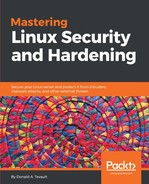LMD's maldet daemon constantly monitors the directories that you specify in the /usr/local/maldetect/monitor_paths file. When it finds a file that it suspects might be malware, it automatically takes whatever action that you specified in the conf.maldet file. To see how this works, I'll create a simulated malware file in my home directory. Fortunately, that's easier than it sounds, because we have a website that will help us out.
To create the simulated virus file, go to the page that I've listed in the preceding link.
Scroll down toward the bottom of the page until you see this line of text within a text box:
X5O!P%@AP[4PZX54(P^)7CC)7}$EICAR-STANDARD-ANTIVIRUS-TEST-FILE!$H+H*
Copy that line of text and insert it into a text file that you'll save to your home directory of either virtual machine. (You can name it anything you want, but I'll just name mine testing.txt.) Wait just a few moments, and you should see the file disappear. Then, look in the /usr/local/maldetect/logs/event_log file to verify that the LMD moved the file to quarantine:
Dec 09 19:03:43 localhost maldet(7192): {quar} malware quarantined from '/home/donnie/testing.txt' to '/usr/local/maldetect/quarantine/testing.txt.89513558'
There's still a bit more to LMD than what I can show you here. However, you can read all about it in the README file that comes with it.
